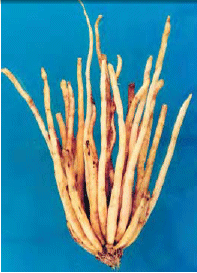
 |
Satish Lele satish.lele@gmail.com |
Introduction: Safed Musli is a tuber crop. Safed Musali belongs to the family of Liliaceae. Safed Musali is partly a herb with sub-erect lanceolate leaves. 17 varieties are found in India. Chlorophytum borivilianum has good market, both in India and abroad. Safed Musali is an annual crop. Safed Musali gives good returns to farmers under irrigated conditions. Safed Musli is found growing in thick forests in its natural form. Safed musli is naturally grown in the hilly areas of Gujarat, Rajasthan and Madhya Pradesh. The natural source is getting fast depleted necessitating field cultivation of this medicinally important crop.
Applications / Uses: The roots of safed musli is reported to contain 2-15% saponin. Safed Musali has medicinal property of enhancing vitality and immunity to human beings. Safed Musali also helps in correcting gynaecological disorders. There are many other therapeutic uses of safed musli where dried tubers are used as a curative for pre-natal and post-natal illness. Safed Musali can cure arthritis. Safed Musali is restorative and a health tonic. Because of its medicinal property, safed musli is known as divya aushadhi and ayurvedic anori.
The Demand : The current demand in India is estimated to be 3,500 tons per year. It is reported that the annual demand for dried safed musli roots is 500 to 600 tons per year in India.
Cultivation Process : Fingers or tubers are commonly used as planting material. Before planting, the fingers are separated in such a way that each finger has a portion of crown disk attached to Fingers or tubers. Seeds can also be used for planting, but for good results fingers are preferred. Tissue culture plantlets can also be used for planting. Sowing starts with the onset of monsoon. Planting of fingers is done in beds or ridges depending on the slope and drainage of the soil. Generally fingers are planted at a distance of 350 to 400 mm. About 80,000 fingers weighing 1,000 to 1,200 kgs are required for planting in one hectare.
Plantation: Safed Musli can be grown in hot and subtropical climate. Normally the agroclimatic conditions suitable for potato, onion and garlic are also suitable for safed musli crop. Well drained soils with rich mineral content is ideal for this crop. Hard and acidic soils are to be avoided. Vermicompost, well decomposed organic manure are major sources of organic manure. 30 to 35 tons of organic manure is applied per hectare to take care of the major and micronutrient requirements of the crop. Vermicompost also does soil conditioning and enhances biological activity.
Processing: After digging out the musli tubers from the soil, they are thoroughly washed in fresh water. The large and healthy fingers are separated from the tubers and the small ones are kept aside to be used as planting material for the next season. The large fingers are taken for processing. The outer brown skin is peeled off with a stainless steel knife. musli tuber is then dried in sun for three to four days. Dried fingers are packed in polythene bags and sent to the market.
Plant Protection: Diseases like leaf spot, anthracnose and wilt affect this crop. Spraying of neem or chrysanthemum or tobacco extracts (upto permitted levels) or application of Trichoderma etc., are adopted under organic growing. Plant extracts and biological agents are also used for pest control.
Harvesting and Yield: Three to four months after planting, the leaves start yellowing. Subsequently they become dry and fall off and get detached from the tuber / disc. The moisture level in the soil should be maintained for another two to three months. After this, the skin of tubers mature and musli tuber turns dark brown. At this stage the tubers and fingers are dug out. On an average yield is 4,000 to 5,000 kgs of wet musli tubers per hectare. After peeling and drying to nearly 20% dry, 800 to 1,000 kgs is finally obtained.



